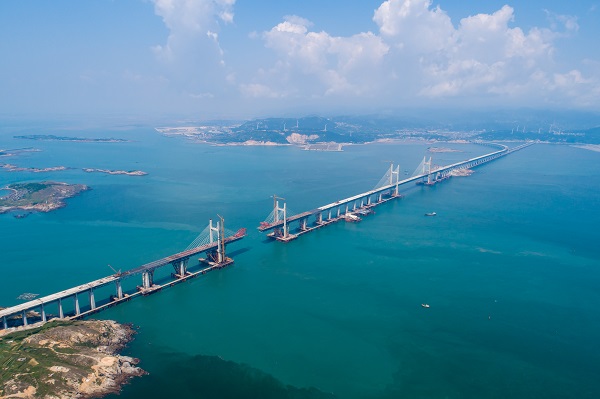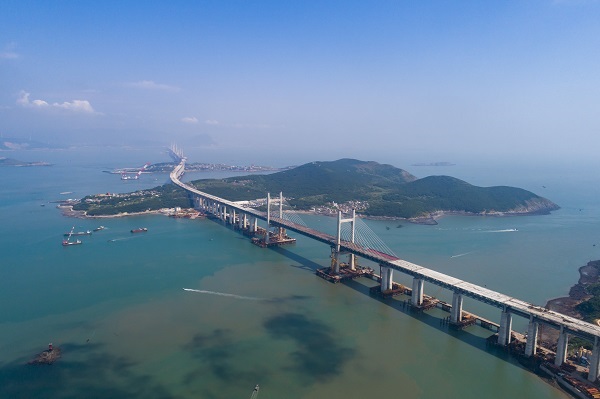World's Most Difficult-to-built Channel Bridge Nears Completion
The Pingtan cross-strait road-rail bridge, the world's most difficult-to-built and first of its kind in China, will be completed by the end of September. It is expected to be open to traffic in 2020, according to China Railway Major Bridge Engineering Group Co., Ltd. on Sept 15.
It was also the first bridge in China to use 4.9-meter super-large diameter drilled pile as a foundation.
Construction of the bridge began in November 2013.
The 16.34-kilometer bridge is a main section of the Fuzhou-Pingtan railway. It starts from Songxia town in Changle, Fujian Province and passes Renyu, Changyu, Xiaolian and Dalian islands. Later, it goes across Yuanhong channel and waterways of Guyumen, Dalian and Xiaolian islands as well as Beidongkou and terminates at Pingtan Island.
The upper layer of the bridge is a six-lane highway with a designed speed of 100 kilometers per hour and the lower layer is a two-lane class I railway with a designed speed of 200 kilometers per hour.
Located at the northern mouth of Haitan Channel, the Pingtan cross-strait road-rail bridge neighbors the Taiwan Strait.
The river mouth is in a typical marine monsoon climate area. With additional funneling between Taiwan Island and the Wuyi Mountains, the location is one of the world's top three windiest gaps. The other two are the Cape of Good Hope in southern Africa and Bermuda in the North Atlantic Ocean.
According to Wang Donghui, deputy chief engineer of China Railway Major Bridge Engineering Group Co., Ltd., the Pingtan cross-strait road-rail bridge faces stronger winds, higher waves, a larger tidal range, a deeper sea and faster water flow than many other places like inland rivers and seas including the Bohai Sea, the Yellow Sea, the East China Sea and the South China Sea.
Reducing on-site construction and engineering is a key to conquering the negative natural factors.
Duan Xuewei, general director of the bridge's design, said long section welding and integral hoisting are used in the cable-stayed bridge of the waterway and the simply supported steel trusses, which was the first time the procedure had been used in Chinese bridge construction.
The bridge has 169 piers, 130 of which are underwater.
A total of 850,000 tons of steel were used in the construction of the bridge, double the amount of the Hong Kong-Zhuhai-Macao Bridge and 20 times that of the Bird's Nest.
The construction team also faces gale weather. According to the statistics collected by the meteorological department, during the construction of the bridge from 2014 to 2018, there were 29 typhoons. Super typhoon Soudelor No.13 had reached grade 14 when it made its landfall on the bridge in 2015.
In addition to strong winds, the builders also overcame difficulties such as strong surges, severe salty-spray corrosion, complicated geological conditions and high sloping seabed rock.
Liu Ziming, Party secretary of China Railway Major Bridge Engineering Group Co., Ltd. said, "Construction of the dual-use bridge has solved difficult problems in complex marine environment, and accumulated experiences in design, engineering and construction. Meanwhile, a full set of technology for dual-use bridge construction in complicated sea areas has been formed, which is of significance for future projects."

The Pingtan cross-strait road-rail bridge, the world's most difficult-to-built and China's first of its kind, will be completed by the end of September this year. [Photo/sasac.gov.cn]

The 16.34-kilometer bridge is a main section of the Fuzhou-Pingtan railway. [Photo/sasac.gov.cn]

Located at the northern mouth of Haitan Channel, the Pingtan cross-strait road-rail bridge neighbors the Taiwan Strait. [Photo/sasac.gov.cn]
(Executive editor: Zhang Tianyuan)



